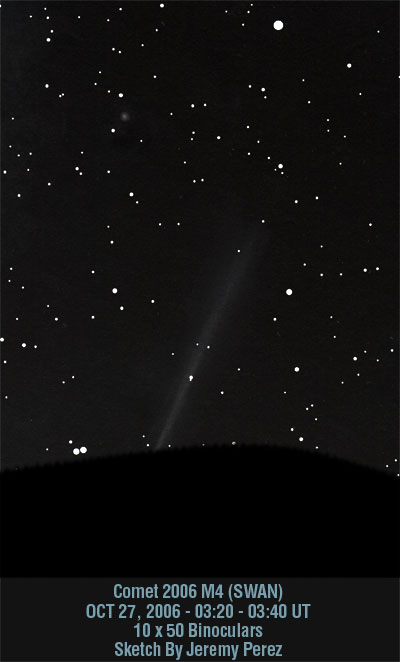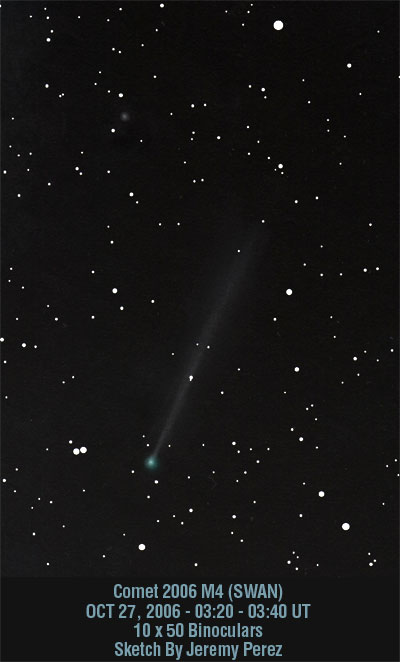Move mouse over upper image for labels.
Background star field printed from Starry Night Pro Plus.
Comet and M13 sketched as observed.

This image shows the view after the coma had set behind Mt. Elden.
Background star field printed from Starry Night Pro Plus.
Comet and M13 sketched as observed.
Observation Notes
I got a very nice look at the comet from my back porch using 10 x 50 binoculars tonight (Oct 27, 2006 03:20 UT / Oct 26, 2006 8:20 PM local). I hope to get the sketch scanned tomorrow, but the ion tail was very nice. Comparing to stars it interacted with, I was able to trace the tail 1.5 degrees from the coma fairly easily, to 3 degrees with some difficulty, and to a total length of 3.5 degrees with a lot of effort. The coma appeared about 7 arc minutes wide and was a beautiful turquoise, which became much more apparent in comparison to M13 which I was able to squeeze into the field with the comet. The coma was strongly condensed, but I had trouble making out structure within. It must still be roughly 4th magnitude, because when I defocused the binoculars, it was brighter than the combined light of the nearby Nu Coronae Borealis pair–both of which are low fifth magnitude stars.
After putting my stargazing glasses on, I was able to put the binoculars down and make a naked eye* observation of the comet as the apex of an equilateral triangle formed with nu and sigma Coronae Borealis. Without the glasses, I couldn’t see it. Even with the glasses, I wasn’t able to convince myself I saw the tail this way.
After about a half hour, the comet began to set behind the looming mass of Mt. Elden a mile and a half to the northwest. It was a mesmerizing sight through the binoculars to watch the soft ball of the coma dim slowly as it began to nestle behind the distant trees, finally leaving only the soft tail to mark its burial. After a couple minutes, I decided that the tail gave the impression of a very distant spotlight shining up faintly from the forest beyond the ridge. After the first degree or so of the tail had set, it became very difficult to pick out the rest, but side to side motions of the binoculars revealed its very subtle mark on the sky. The sketch was prepared on a pre-printed star field from Starry Nights Pro Plus. I then sketched the comet and M13 as I saw them through the binoculars.
I wish I could have set the scope up on it, but perhaps tomorrow. If it stays this bright through through the same time tomorrow night, I’m pretty sure the tail will just encompass M13 visually, and I bet the overlap will be pretty obvious photographically.
Object Information:
| Subject | Comet 2006/M4 (SWAN) |
| Classification | Comet |
| Position* | Corona Borealis 03:20 UT – [RA: 16:19:51.9 / Dec: +34:36:51] |
| Size | Coma: 7′ |
| Brightness | ~4.5 vMag |
| Date/Time | October 26, 2006 – 8:20 – 8:40 PM MST (October 27, 2006 – 03:20 – 03:40 UT) |
| Observing Loc. | Home – Flagstaff, AZ |
| Instrument | 10 x 50 Binoculars |
| Eyepieces/Mag. | — |
| Conditions | Clear, calm |
| Seeing | 5/10 |
| Transparency | Mag 5.8 + NELM |
| *Sources | Starry Nights Pro Plus v. 5.8 |
